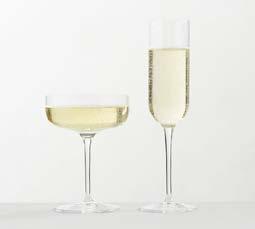
3 minute read
TYPES OF WINE GLASSES
TYPES OF WINE GLASSES
Wine is known as a sophisticated and luxurious drink. Many types of wines are invented around the world, but whether sweet or dry, white or red, robust or light, wine requires very specific serving procedures in order to reach its full flavor potential. In addition to proper serving temperatures, each type of wine requires a specific style of glass for service.
Advertisement

Anatomy of a Wine Glass
A wine glass is composed of four parts – the base, the stem, the bowl, and the rim.
The base: usually has a circular shape to keep the cup upright.
The stem: varies in length depending on the type of wine served. This is also a place where the handle helps avoid fingerprints when holding the glass, while helping the wine to stabilize the temperature to help the flavor of wine served stays ‘original’.
The bowl: usually has an “U” shape which are stroked upwards to create a sense of elegance and sophistication. Different types of wine glasses have a clear difference in the shape and bulge of the wine.
The rim: this is the most important part of the glass, deciding the taste of wine that people enjoy. The Rim is made by advanced laser cutting technology to ensure the rim is always thin, rounded to help drinkers fully enjoy the taste of wine.
Red Wine Glasses



Below are the typical characteristics of a red wine glass:
- Large glass with a full, round bowl and large opening
- Opening enables you to dip your nose inside to detect the aroma
- Full bowl provides air contact for the complex aromas and flavors
- Increases the oxidation rate, which smooths out the complex flavors
White Wine Glasses

Below are the typical characteristics of a white wine glass:
- Bowl is more u-shaped and upright than a red wine glass
- Slightly smaller bowl than red wine glass
- The shape enhances and preserves aromas while also maintaining the wine’s cool temperature
Sparkling Wine and Champagne Glasses

Below are typical characteristics of sparkling wine glasses:
- Upright, narrow bowl to preserve carbonation and flavor
All-Purpose Wine Glasses

If a single glass type is all that your circumstances permit, an all-purpose wine glass is the way to go. Although the experience may not be the same as when you use the proper glass type for the application, these glasses offer a similar function at a lower cost and increased efficiency.
Crystal vs. Glass Wine Glasses
Below we go through the differences between crystal and glass, so you can choose the best material for your needs

Crystal wine glass
Crystal wine glasses enhance the aromas in wine and offer an elegant design, making them perfect for high-end dining rooms and formal events.
Pros: Can be spun very thin to create a very thin rim Yields a smoother drink flow against the tongue because it eliminates the thicker lip edge
Cons: More expensive than glass Very fragile; can easily break Porous and must be washed by hand

Glass wine glass
Glass wine glasses are more durable than their crystal counterparts, making them a better fit for bustling casual restaurants and bars.
Pros: More durable and less likely to break. Non-porous and usually dishwasher safe. Less expensive
Cons: Not as delicate as crystal Usually not as well designed as crystal glasses to enhance wine’s flavors









